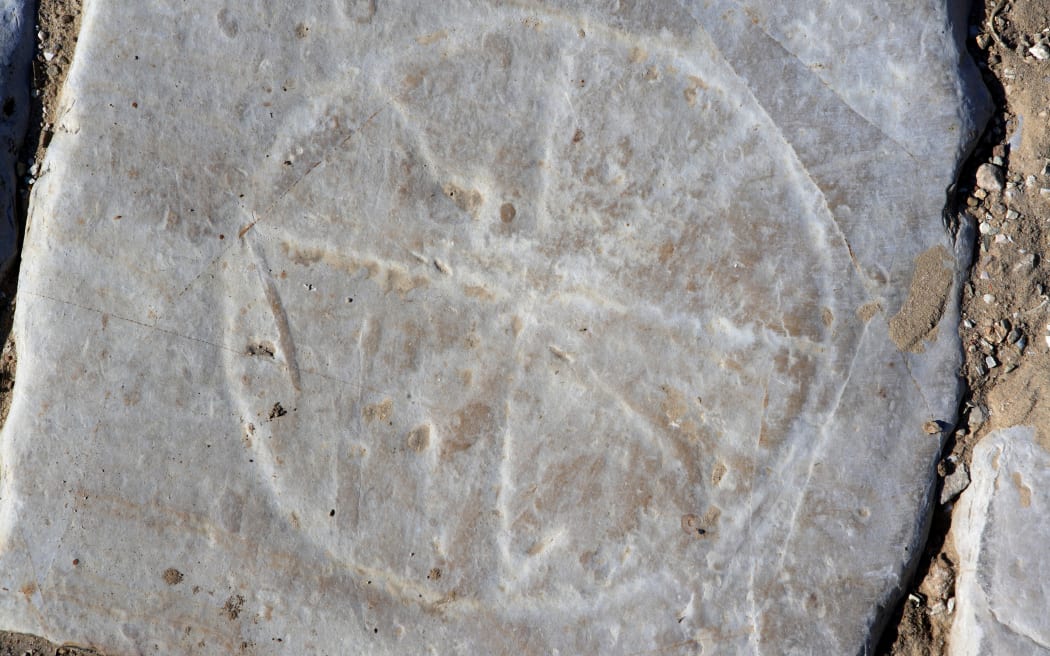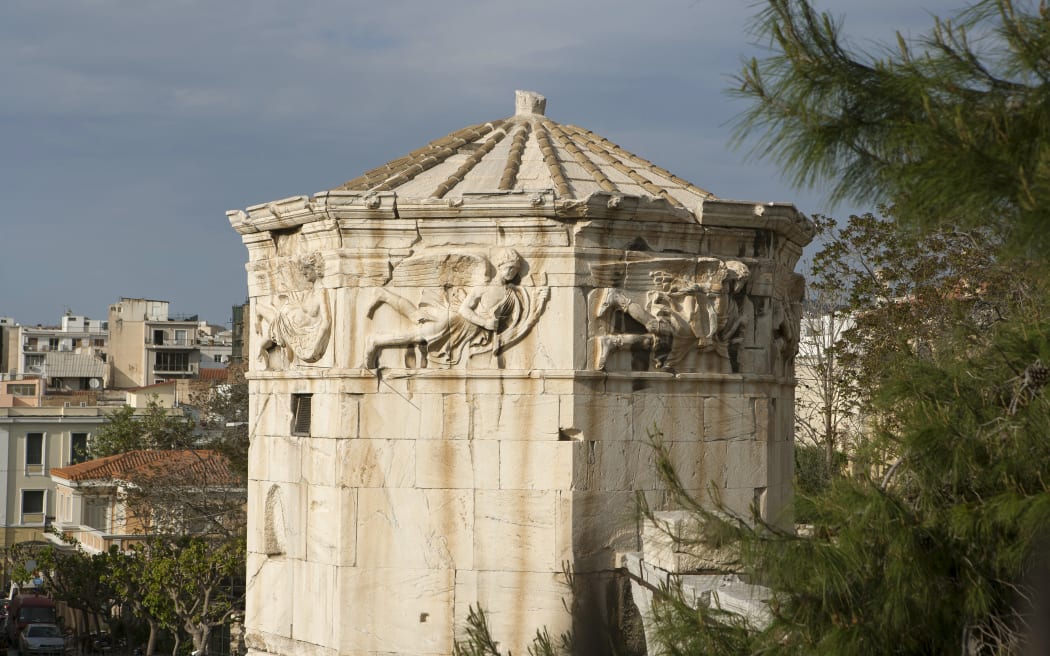By Zaria Gorvett, features correspondent for BBC News

A sundial in the ancient Roman settlement of Volubilis, northern Morocco. Photo: AFP/Manuel Cohen
In ancient Rome, an hour was not a consistent unit of time. In the summer, it could be as long as 75 minutes - and in the winter it sometimes lasted just 45 minutes.
At first it just appeared to be a plain block of carved stone.
The limestone lump was lying face-down in the mud at the site of an ancient Roman town in central Italy, and it was thoroughly stuck. It's thought that the block was stolen in the medieval era - plucked from the metropolis' antique remains and dragged away, possibly with the intention of using it as building material. But the mud had thwarted this attempt, and here it was, still in position, hundreds of years later.
It took a team of three people to prise the stone out, and as they did so, Alessandro Launaro yelped with delight. "The first thing I remember saying is 'Woah! Inscription!'", he says. The block had left behind an imprint of Latin letters and mysterious lines, pressed into its muddy grave like a stamp. "And that I found really puzzling," says Launaro, an associate professor of classics at the University of Cambridge.
Once the rock had been safely extracted from the ground, its purpose became clear: this was an ancient Roman sundial, one of many hundreds which have been discovered across the globe. After its peaceful sleep entombed in mud, it was exceptionally well-preserved - with lines that demarcated each passing hour, and an inscription crediting the official who paid for it. But perhaps the most exciting part was the way it demonstrated the ancient Roman solution to a perennial dilemma: how to make the most of the daylight available at different times of the year.
Twice a year, around a third of the world's countries perform a hotly debated ritual: meddling with time to create longer summer evenings and brighter winter mornings. The US, the UK, and most of Europe implement Daylight Savings Time (DST), which involves pushing the clocks forward by an hour for the spring, then pulling them back by an hour to regular Standard Time in the autumn. But the ancient Romans had no such system - instead, they practised the long-forgotten art of seasonal hour-stretching.
Just like we do today, the ancient Romans divided up each day into 24 units - but for the vast majority of the year, they were not of equal length. All the daylight hours were divided by 12, all year round. This meant that at the peak of summer, when the Sun is up for longest, an hour took 75 minutes during the day, and just 45 minutes at night. In the middle of winter, meanwhile, when daylight was in shortest supply, the pattern was reversed - and during the day an hour occupied just 45 minutes.
"And then gradually between the summer solstice and the winter solstice, the length of those hours would change day by day, just a little bit each day," says James Ker, professor of classical studies at the University of Pennsylvania. By the equinox - a moment that occurs twice a year, when the Sun is directly above the equator, and days and nights are roughly the same length - an hour was a familiar 60 minutes.
With this bold, time-bending system, the ancient Romans never wasted a single moment of daylight - if the Sun was up, it was officially daytime, and they would often be at work. If it was down, it was declared to be the evening - and time for a spot of leisure or sleeping.

A view from above of a Roman sundial in the pavement in Carthage, Tunisia. Photo: AFP/Manuel Cohen
Reading time, the ancient Roman way
Launaro's sundial, which was discovered at the site of the ancient Roman town of Interamna Lirenas in 2017, isn't quite like modern sundials. Instead of being flat and circular, it's shaped like half a bowl that's been split down the middle, with lines radiating out from the centre to the edge that divide it into 12 portions for the hours. The sundial's face is further subdivided by intersecting lines at the top, bottom, and middle of the bowl, which indicate the season - the winter solstice, the equinoxes, and the summer solstice.
At one time, a lead needle - known as a gnomon - would have cast a shadow of varying lengths depending on the height of the Sun, though this detail snapped off long ago. To read the sundial, you would simply check which segment the gnomon's shadow fell in, as you would with any modern version.
On the afternoon of 24 August AD79, when Mount Vesuvius began to erupt at the city of Pompeii, the 36 sundials eventually discovered in the wreckage would have been read using the outer ring of lines. And with longer gaps between the hourly demarcations further out from the sundial's centre, it would have taken longer for each hour to elapse. At this time of year, an hour would have taken around 70 minutes.
"So this concept of an hour for the Romans varies depending on the time of the year," says Launaro. "Even something as fundamental as timekeeping was quite different for them from the way we conceptualise it now."
Though to modern ears, the ancient Romans' penchant for stretching and contracting the length of an hour might sound fiddly or even baffling, enacting it was easier than it sounds. That's because most of the time, people didn't attempt to keep track of the hour in their heads - sundials were ubiquitous.
These impressive objects were usually made of vast, hefty chunks of stone that remained in one place for their entire lifetime. They could come in quirky styles, such as the famous "pork clock", a prosciutto-themed sundial shaped like a cured ham, with a curly pig's tail instead of a needle to conduct the Sun's shadows and indicate the time.
Today there are up to 600 surviving ancient Greek and Roman sundials, 99% of which adhered to this seasonal system of timekeeping - which was invented by the ancient Egyptians, and later adopted by other early civilisations. "They were everywhere, they were the private spaces, like private gardens, they were in public places. Pretty well anywhere you went [in the Roman world], particularly in the time of the Roman Empire, you would come across them," says Alexander Jones, professor of the history of the exact sciences in antiquity at New York University, New York.
Like many ancient sundials, it's thought the one at Interamna Lirenas would have originally sat on a high column or pillar in the Forum - a kind of plaza that formed the heart of public life in any Roman city. Placing the instruments high up allowed them to catch the light even in the presence of tall buildings, so onlookers always had a clear view of the time - depending on the quality of their eyesight. "You'd have to try to read the time off the sundial from ground level, looking up to something that is maybe six metres up," says Jones. This may also explain why so many surviving sundials were stripped of their markings long ago, having spent years out in the open, battered by the elements.
While early sundials tended to have inscriptions with instructions on how to read them, Jones explains that eventually - by the height of the Roman Empire - everyone would have known how to do this. "Later ones just have the lines and they won't even have numbers written on them, usually. So people must have learned how to read them," he says. Households that didn't have their own sundial would regularly send slaves off to find the nearest public one and report back the time.
And everyone had a more relaxed attitude to the time anyway, says Jones. "We make appointments for a quarter after the hour, something like that - that doesn't happen in ancient times. If you make an appointment for a particular hour, that's about as refined as it typically gets," says Jones. It was rarely necessary to attempt to calculate the length of a seasonal hour.
However, the constantly-shifting length of a Roman hour did attract some comments. "You do hear phrases like, 'huh, well, in a winter hour'", says Ker, who likens it to a New York minute - an extremely short minute, once compared to the time between a traffic light turning green and the person in the car behind honking their horn.
Ker gives the example of a Roman poet who boasted that his book could be read in as little as an hour - then specified that he didn't just mean in any hour, but a winter hour. This was even more impressive, because this unit could take as little as 45 minutes. "There was a kind of way of talking about hours which would capture their elasticity," he says.

The Tower of the Winds in Athens, Greece is an octagonal marble structure that serves as a water clock, sundial and weathervane. It dates from the second or first century BC. Photo: AFP/Manuel Cohen
Surviving short nights and long days
Of course, the flipside of having long summer days and short winter ones was the nights. There were still only 1,440 minutes in every rotation of the Earth on its axis relative to the Sun - so every minute allocated to the daytime was essentially stolen from the night. This meant that at the peak of summer, while a day was 900 minutes long, a night only occupied 540 - the equivalent of just nine hours in modern time to have dinner, socialise and sleep.
These truncated summer nights could pose a problem, because just like people today, the ancient Romans were obsessed with getting enough sleep. Enter a hack pioneered by the emperor Marcus Aurelius, which allowed his court to rest for longer - and provided a rare example of rebellion against the seasonal fluctuation in the amount of daylight.
"During the summer, instead of waiting until sunset to let his attendants go [as was typical], he knocked off at around, I think, the 10th hour of the day. And what this meant was that they had enough time to go home, maybe exercise, maybe have dinner, and then still get eight hours of sleep," says Ker.
Tracking the passage of these ever-changing night hours could be tricky. That's because naturally, sundials didn't work after sunset. Instead the only option was the water-clock, which worked a bit like an hourglass - the amount of water that had passed through indicated the amount of time that had elapsed.
However, very few water-clocks have survived from the Roman era, says Jones. One reason might be that they had a lot of moving parts, unlike sundials which tended to be made from a single, large block of stone. But he also believes that they were never as common as sundials - they were expensive, high-status items.
It would have been perfectly possible for those in possession of a water clock to make an hour a standard length at night. But this is not what ordinary people wanted. "And so the really incredible thing is that they made water clocks that would be adjustable, so that they would also track hours that varied through the seasons," says Ker. "They were so committed to the system [of hour-stretching and contracting], that even at night-time they used a different device that would correspond to what the sundial was tracking," he says.
In fact, the only people who obeyed the modern length of an hour in ancient Rome were doctors and astronomers, who needed greater precision for their patients and calculations. Instead they used the so-called equinoctial hour, named after the two moments in the year where the amount of daylight and darkness is exactly equal, and an hour would have taken 60 minutes.
But whether a civilisation uses the antique method of hour-stretching, or the modern technique of daylight savings, of course we can't actually increase the amount of daylight available - only tweak the edges of how we use it. "You can't manipulate nature, you can't change the time that's available for doing productive work [outside]," says Jones. That's just something people have to live with."
This story was originally published by BBC News.





